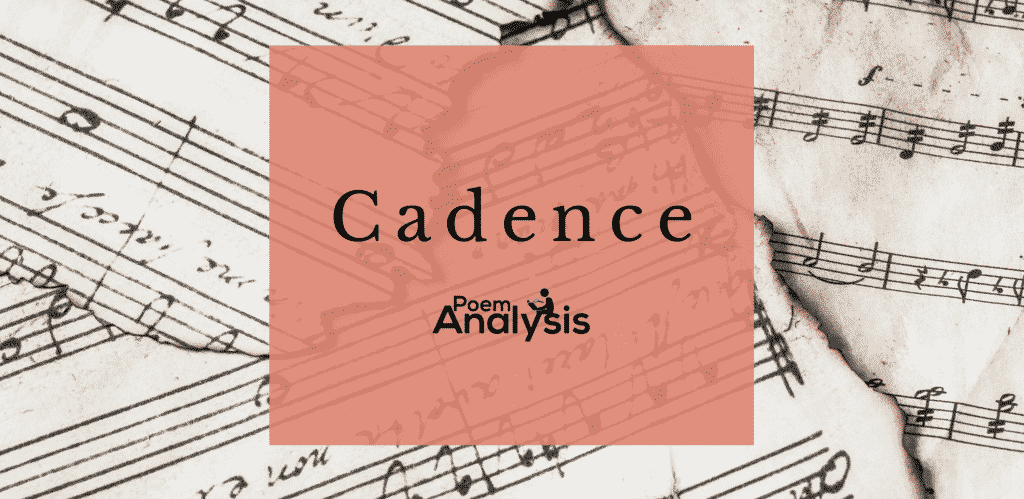While cadence is most commonly associated with works of literature that include a rhyme scheme and metrical pattern, it can also be used in free verse poetry and prose. When seeking out the cadence of a poem, readers should look for the way that words connect to one another. What similarities do they have? How does one sound next to another? Writers put a great deal of time into the arrangement of their sentences, choices are not made without a reason.
The word “cadence” comes from the Italian word “cadenza,” and before that, the Latin word “cadere,” meaning “to fall.”
Definition and Meaning of Cadence
Cadence is the natural rhythm of a piece of text, created through a writer’s selective arrangement of words, rhymes, and the creation of meter. It can occur in free verse poetry, prose, as well as structured poetry. It is also created through the rise and fall of a person’s voice. There are patterns to speech, ones that come out in poetry and prose, especially when read out loud. When seeking out evidence of cadence, it’s important to look at the organization of paragraphs and stanzas as well as the use of punctuation and word arrangement.
Types of Cadence
There are generally agreed to be two types of cadence, imperfect cadence, also known as half cadence, and perfect or authentic cadence. The latter comes at the end of the phrase in a poem. It refers to moments in which full and half-rhyme are used at the ends of lines, as well as at the ends of lines that create examples of caesura. It can be seen in ‘The Raven’ by Edgar Allan Poe.
Imperfect cadence is less obvious than it’s perfect variation. It can be seen when the poet uses techniques like caesura and other pauses in the middle of lines, requiring the reader to take their time through a particular passage. These examples alter speech but less decisively.
Examples of Cadence in Poetry
My Papa’s Waltz by Theodore Roethke
In ‘My Papa’s Waltz,’ a musical, strange poem that appears to depict a speaker dancing with his father through the kitchen, the poet uses a great deal of musical-sounding cadence. It is used to create rhythm by breaking up lines with enjambment and semi-colons. For example:
We romped until the pans
Slid from the kitchen shelf;
My mother’s countenance
Could not unfrown itself.
The poet is able to move between the depiction of the “dance,” which is revealed to be abuse at the hands of the father and the mother’s disapproval. This poem is also a good example of how a reader’s voice might change as they learn more about the situation. When one line might start out more positive-sounding, it can then end on a more negative note when the truth of the poem comes through.
Song of Myself by Walt Whitman
Whitman’s ‘Song of Myself’ is a perfect example of a free verse poem that also has wonderful cadence-filled lines. In this long poem, the lines are of different lengths. He uses techniques like caesura, enjambment, and end-punctuation in order to change how the reader takes in each piece of the poem. There are also good examples of consonance and assonance throughout. For example, look at these lines from ‘Song of Myself’:
I celebrate myself, and sing myself,
And what I assume you shall assume,
For every atom belonging to me as good belongs to you.
I loafe and invite my soul,
I lean and loafe at my ease observing a spear of summer grass.
These lines also have examples of repetition; for instance, “loafe” and “belong.”
The Raven by Edgar Allan Poe
‘The Raven’ is one of the best examples of cadence in English poetry. It is filled with examples of half-rhyme, full-rhyme, caesura, and interesting uses of punctuation. It is furthered by repetition and complete refrains. Take a look at these lines as an example:
Once upon a midnight dreary, while I pondered, weak and weary,
Over many a quaint and curious volume of forgotten lore—
While I nodded, nearly napping, suddenly there came a tapping,
‘ ‘Tis some visiter,’ I muttered, ‘tapping at my chamber door—
Only this and nothing more.
It’s also important to note other examples of literary devices like alliteration in the first line and how that furthers the overall rhyme and creates cadence.
Why Do Writers Use Cadence?
Cadence is important in writing because it creates pleasing lines of verse and prose. Without cadence, one writer’s work would very likely sound similar to another and quite uninteresting. A writer’s cadence is often a marker of their style. Someone like Earnest Hemingway can be said to have a very different cadence than someone like Edgar Allan Poe.
Cadence is incredibly important in poetry in that it allows one sound or one word to link to another. This might be through enjambment, alliteration, or several other techniques. It’s also important to consider how cadence changes the way that readers understand a work of literature. Does it make the poem or section of prose sound more fluid? Dark? Disjointed? These are all things that writers think about and make a choice in regard to in order to craft their work.
Related Literary Devices
- Lyric Poem: a musically inclined, short verse that speaks on poignant and powerful emotions.
- Alliteration: a technique that makes use of repeated sounds at the beginning of multiple words, grouped together. It is used in poetry and prose.
- Enjambment: occurs when a line is cut off before its natural stopping point.
- Caesura: a break or pause in the middle of a line of verse. These breaks can be towards the beginning, middle, or the end of a line.

